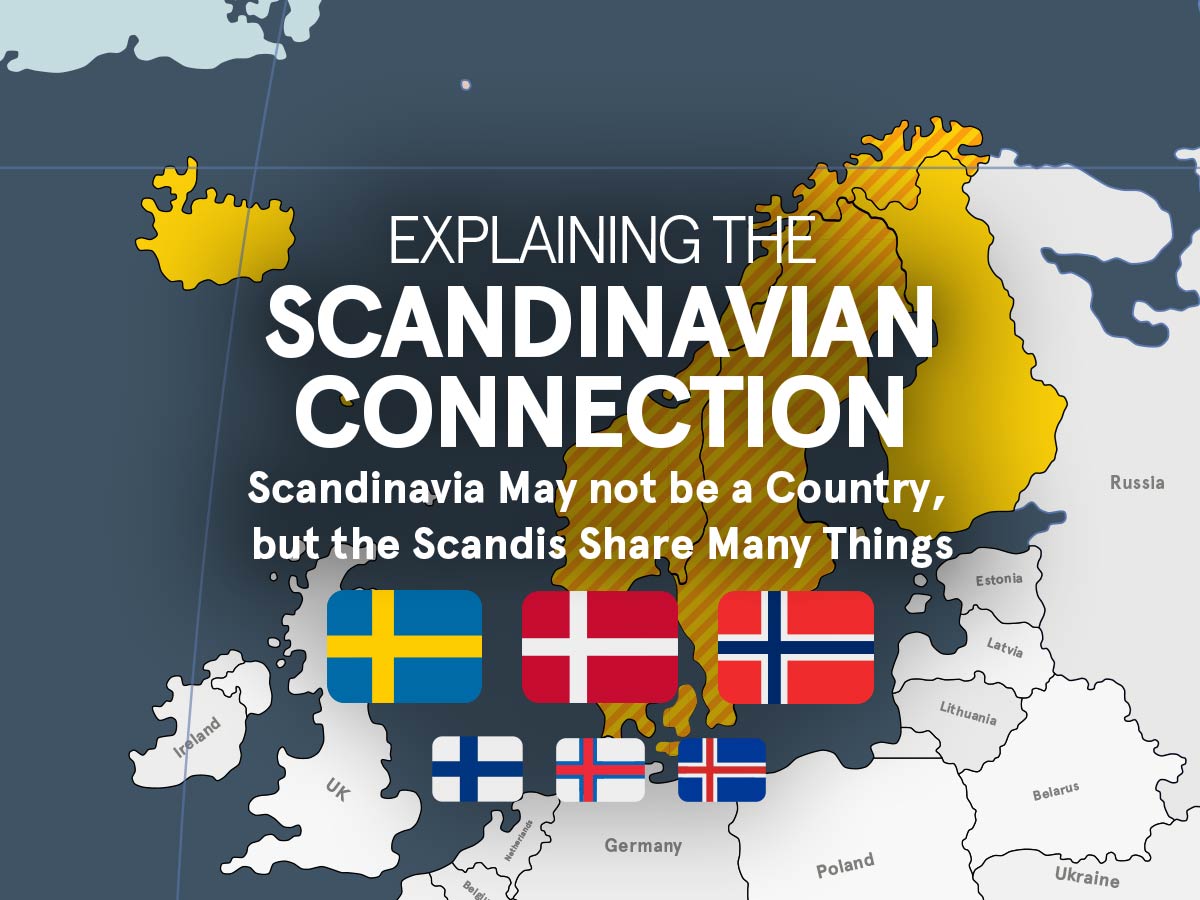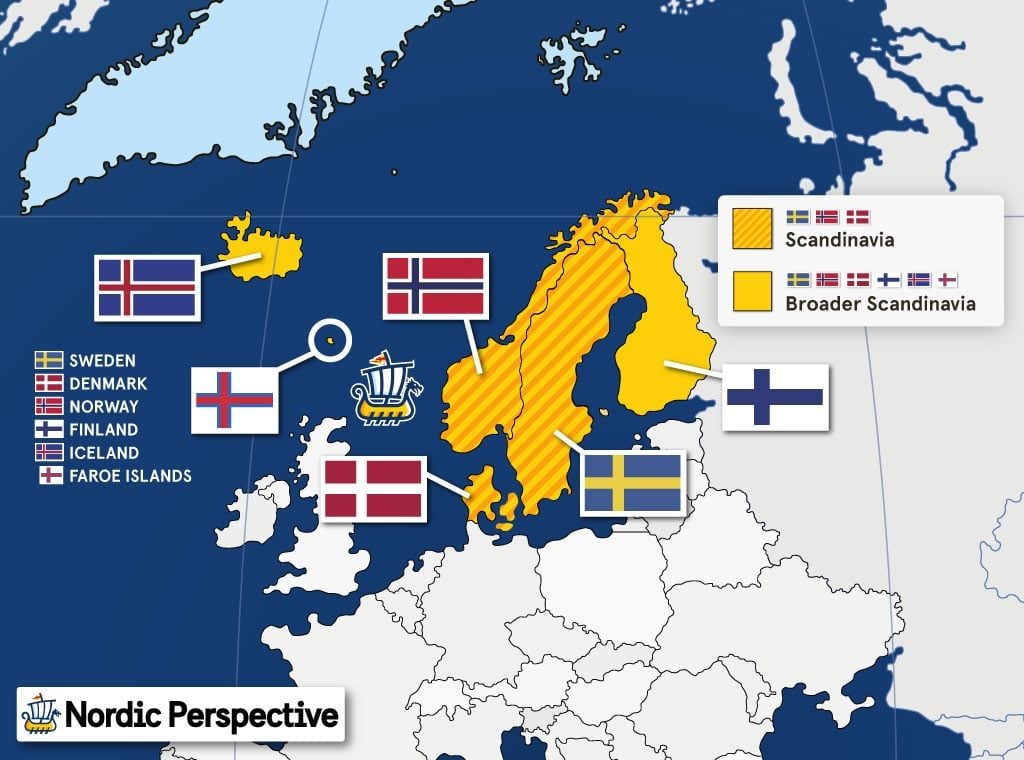Don’t worry, you’re definitely not alone in wondering this — I’ve come across this question so many times during my travels, especially when I introduce myself as a Scandinavian:
So… Is Scandinavia a country?
Scandinavia is a region of three countries—Sweden, Denmark, and Norway—and not a single country or union. These countries share a culture rooted in a common origin, history, and language, and Scandinavians also tend to agree on most politics and share some core values in modern times; including transparency, innovation, environmentalism, equality, and trust in each other and authorities.
It should be added that in some parts of the world (primarily the US and the UK), the broader Scandinavian term may also refer to the people and countries of Iceland, the Faroe Islands, and Finland — but this is not how we locals define Scandinavia.
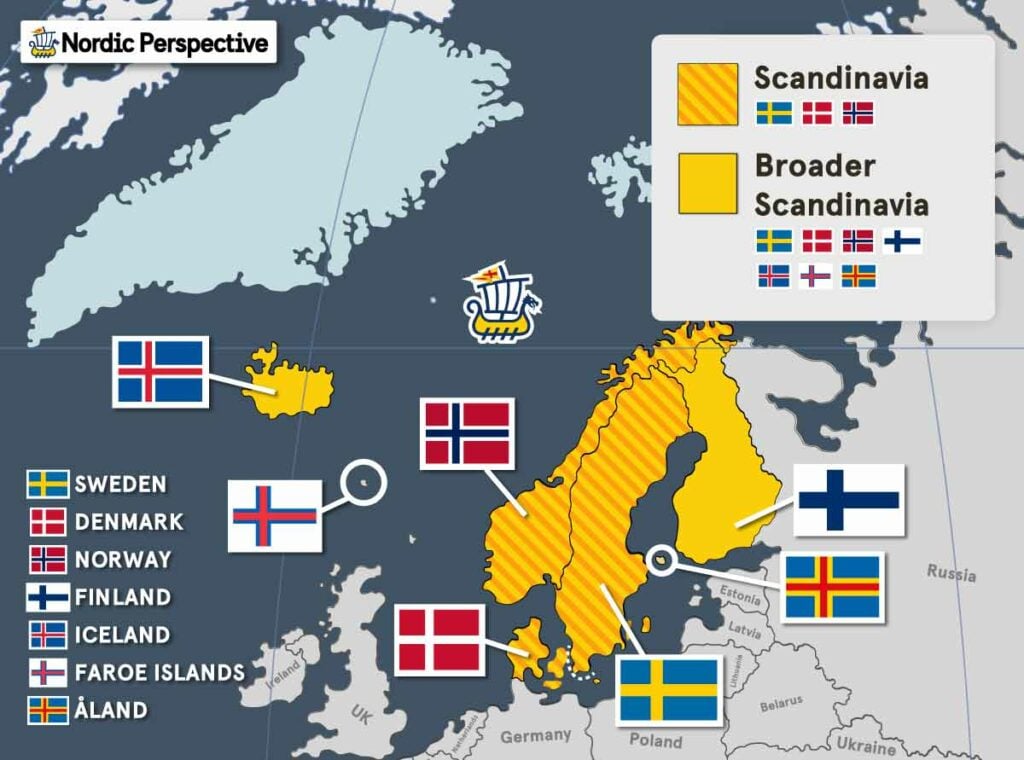
So How Exactly are Scandinavians Connected?
So why do I call myself a Scandinavian if it’s not a country? Well, Sweden (where I’m from) is a small country in the grand scheme of things, and it’s sometimes easier to refer to a larger region that more people are likely to know about.
Rune Circle Metal Wall Art
Metal wall art featuring and inspired by designs found in archeological sites from Viking Age Scandinavia. Free shipping worldwide.
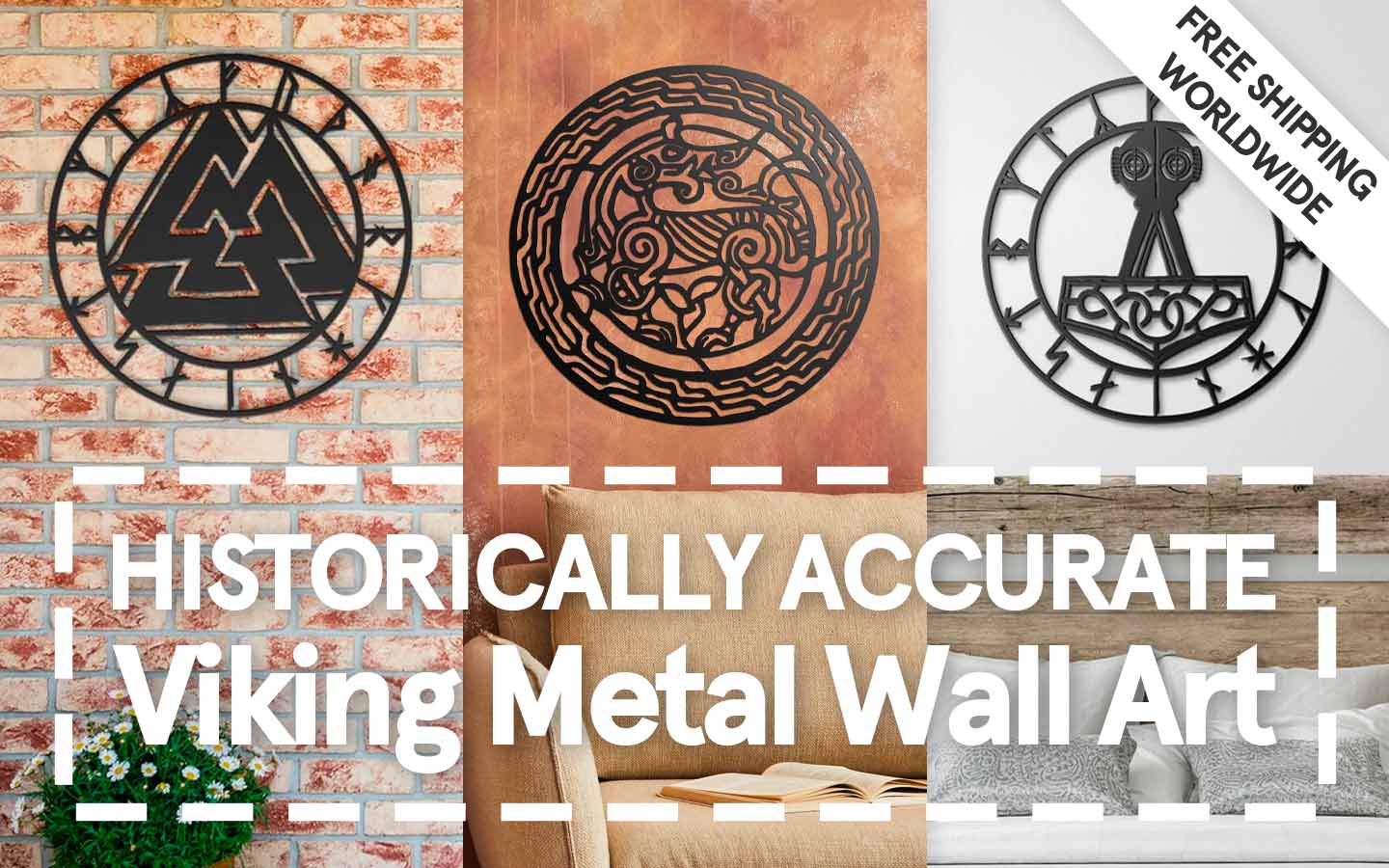 Visit Our Shop
Visit Our Shop
I definitely feel connected to the region as a whole, and in some situations, I may get more understanding nods from the group I’m speaking to instead of puzzled faces wondering where the heck Sweden is.
This Scandinavian connection comes from a common history; we share the same origin story and can trace our common ancestors back to the first inhabitants of the region (of course mixed with wave after wave of immigrants over the years).
Though we have changed a lot over time and had our fair share of conflicts and disagreements, the Scandinavian people have essentially shared a similar culture and values from the Bronze Age up until today.
That’s a 14,000-year-old Scandinavian connection; no wonder we are hard to tell apart sometimes!
ℹ️ Though they might sound similar to you, Scandinavians actually do not speak the same language or even understand each other’s languages that well these days.
If you want to dig a bit deeper into Scandinavian languages, I have written an article that goes into “more detail about the different Nordic languages and how they compare. It also includes the best and worst Scandinavian languages to learn.
To illustrate this, when I run into fellow Scandinavians whilst traveling, there’s always a mutual sens of an instant connection made, and a common ground we can stand on right from the start — even if we have to speak English with each other sometimes.
So what exactly is the difference between us Scandinavians? Let’s go through some basic facts about the different Scandinavian countries and their people, and learn what is and isn’t Scandinavian:
The Scandinavian Countries & People
🇸🇪 Sweden Quick Facts
Official name: Kingdom of Sweden
Meaning: “The land of the Swedes“
Location: Northern Europe
Capital: Stockholm (pop: 2 428 987 in 2022)
Languages: Swedish, Sami
Population: 10 493 565 (July 2022)
Total Area: 173 860 sq mi
Consolidated: Around 1100, gained independence in 1523
🇩🇰 Denmark Quick Facts
Official name: Kingdom of Denmark
Meaning: “The Danish march“
Location: Northern Europe
Capital: Copenhagen (pop: 2 135 634 in 2022)
Languages: Danish, Faroese, Greenlandic
Population: 5 910 577 (July 2022)
Total Area: 16 580 sq mi
Consolidated: Late 8th century
🇳🇴 Norway Quick Facts
Official name: Kingdom of Norway
Meaning: “The Northern way“
Location: Northern Europe
Capital: Oslo (pop: 1 019 513 in 2022)
Languages: Norwegian, Sami
Population: 5 455 582 (July 2022)
Total Area: 148 729 sq mi
Consolidated: 872, gained independence in 1905
Data sources: Sweden, Denmark, Norway
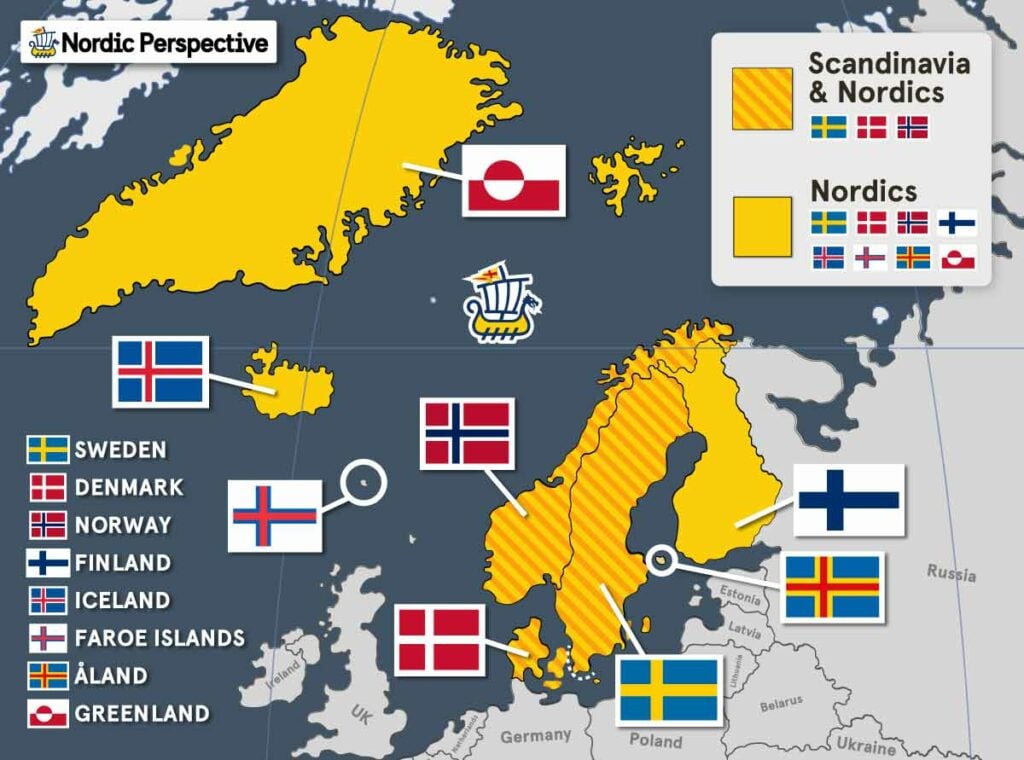
Broader Definition of Scandinavia (vs the Nordics)
There is a broader definition of Scandinavia used in some parts of the world (such as the US, UK, Canada, Australia) which sometimes include Finland, Iceland, Åland, and the Faroe Islands when referring to Scandinavians.
This broader definition is more similar to what we call the Nordic region locally, which includes the countries of Sweden, Denmark, Norway, Finland, Iceland, the Faroe Islands, Åland, and Greenland.
I did a deep dive into the differences between the terms Nordic and Scandinavian not so long ago, so if you’re still not sure what the difference between the two is and would like to find out once and for all, head on over and read that article.
Where is Scandinavia Located?
The three countries of Scandinavia are part of the European continent and are located in the Nordic region in Northern Europe. The nearest neighboring countries to Scandinavia are Finland, the Baltic countries (Estonia, Latvia, and Lithuania) and Russia to the east, and Germany and Poland to the south.
Is Finland Part of Scandinavia?
Formally and locally speaking, Finland is generally not considered part of the Scandinavian region or the Scandinavian people (Sweden, Denmark, and Norway). However, the broader Scandinavian definition commonly used in the US includes Finland, Iceland, Åland, and the Faroe Islands when referring to Scandinavia and Scandinavians.
A small part of northern Finland is technically part of the Scandinavian peninsula though, bordering both Norway and Sweden. Finland has also been part of both Sweden and a Scandinavian union (the Kalmar Union), so the Scandinavian ties are still strong to Finland, although sometimes with a bad connotation.
When including Finland with the Scandinavian countries the terms Fenno-Scandinavia or Fennoscandia are sometimes used.
ℹ️ I wrote an article diving deeper into whether Finland is Scandinavian or not, so if you want to find out more about Finland’s links to Scandinavia go check that out.
So why aren’t the Finns Scandinavian?
The short answer is that the Finns do not share the same origin story that Scandinavians do, having their own unique story of how they came to the Nordic region (which both are part of).
I have also written an article about Finnish heritage and the origin of the Finns, so go and check that out if you’d like to find out more about the fascinating Finnish history.
What is the Scandinavian Peninsula?
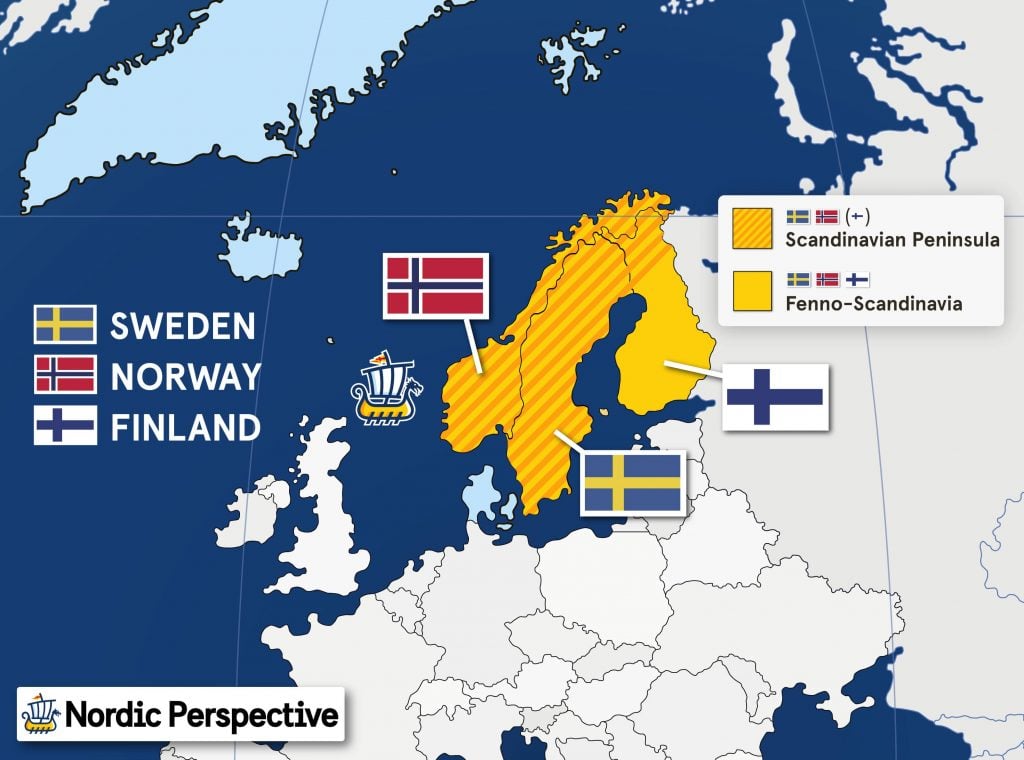
The Scandinavian peninsula is located in northern Europe and is made up of the mainland areas of Sweden, and Norway, as well as small parts of northern Finland and northwestern Russia where the peninsula connects to the main continent.
When Roman historians and explorers first came into contact with this area, they wrongly believed the Scandinavian peninsula was an Island separated from the European continent (much like Britain).
Interestingly, Denmark is the only Scandinavian country not located on the Scandinavian peninsula, as it is instead located on the Jutland peninsula and an archipelago of 443 larger and smaller islands.
Are the Scandinavian Countries United Politically?
Although the three Scandinavian countries do share a common origin, history, language group, and culture—and even agree on most modern-day politics—the Scandinavian region is not unified by a common governing body (such as the EU or the US, for example).
The countries each have their own separate governments, and despite being part of the same Scandinavian language group, the three languages aren’t really mutually intelligible (although especially Swedish is widely understood among young Danes and Norwegians).
That said, within the larger Nordic region (which formally includes Sweden, Denmark, Norway, Finland, Iceland, the Faroe Islands, Greenland, and Åland) there is a regional co-operation agreement in effect through the Nordic Council (formed in 1952).
The Nordic Council of Ministers is made up of 87 elected representatives from all the countries in the council, and was formed to foster cooperation between the Nordic countries and “to make the Nordic region one that people want to live and work in”.
Have the Scandinavian Countries Ever Been United?
Parts of the Scandinavian region were united politically under one government in the 14th century by house Bjälbo, and then completely by the mother of Olaf II (the last Bjälbo King), Margarete I (and her descendants) between 1376-1523:
🇸🇪🤝🇳🇴
Sweden and Norway in union under the House of Bjälbo
The two countries were united under one crown with two succesive kings: Magnus Eriksson and his son Håkan Magnusson of the House of Bjälbo. This family was also called the Folkungs, and was an Ostrogothian Swedish family that held the title of Jarl of Sweden during the 11th, 12th, and 13th century, ultimately elevated to Kings of Sweden in the late 13th century.
🇩🇰🤝🇳🇴🤝(🇸🇪)
Denmark, Norway, Skåne, & Gotland in union under the House of Bjälbo
Håkan Magnusson of the House of Bjälbo separates Norway from the Swedish union, and eventually puts forth his son Olof as candidate to be the next King of Denmark, which he was elected in 1376. After he also became King of Norway in 1380, he ruled over large parts of Scandinavia that included Norway, Denmark, Skåne and Gotland.
Upon the death of Olof, his mother Queen Margerete assumes the position of regent in Denmark and Norway.
🇩🇰🤝🇳🇴🤝🇸🇪
Scandinavia is united in the Kalmar Union under Queen Margarete and her son Eric of Pommerania
Eric was the son of a Polish Duke and a very distant (and the only male) relative of Queen Margarete of Denmark. When her son King Olof died in 1387, she adopted Eric as he was the only possible male heir who was still alive and related to the Queen.
The whole of Scandinavia is finally united by Queen Margarete, under her adoptive son (who were of the House of Griffin, the Dukes of Pommerania).
The union lasts (more or less) for 126 years, ending with the Swedish war of independence in 1523, in response to Kristian II “The Tyrant” ordering the “Stockholm Bloodbath”.
Scandinavia once again becomes three independent and separate kingdoms.
So a tyrannical King in the 1500s was the nail in the coffin for the dream of a united Scandinavia that started with the Bjälbos from Sweden slowly uniting the three countries through marriages and strategic alliances in the 1300s.
The last regents of the Kalmar Union were of the Wittelsbach dynasty from Bavaria, which interestingly is also where the British royal family stems from. Although this branch is now called the House of Windsor.
The Scandinavian Languages
🇸🇪 Swedish
Swedish is an East Nordic language spoken by around 10 million people, making it the most common Scandinavian language. It is the main language of Sweden, and also a minority language in Finland where they still have some Swedish-speaking parts along the coast and the border to Northern Sweden.
The autonomous island region of Åland is also Swedish-speaking, situated in between Sweden and Finland (and officially part of Finland).
🇩🇰 Danish
Danish is an East Nordic language spoken by around 6 million people. It is the main language of Denmark, and is also spoken by many in the Faroe Islands and Greenland (both self-governing countries within the Kingdom of Denmark).
🇳🇴 Norwegian
Norwegian is a West Nordic language spoken by around 4.5 million people, which also makes it the smallest Scandinavian language. It is the main language of Norway.
ℹ️ If you’re interested in the Scandinavian languages and how they compare, I’ve written an article where I dive deeper into how Swedish, Danish and Norwegian sound, which is easier to learn, and how useful each language can be.
Are the Scandinavian Royal Families Related Today?
As most of the European royal houses are related somehow, it’s fair to assume that the Scandinavian ones are too. And as we saw further up in the article, they were even ruled by the same Kings and Queens over long periods. So how exactly are the Scandinavian royal families related?
The Scandinavian royal families are all related through a succession of marriages starting with the Danish King Frederik VIII marrying the Swedish Queen Louise, eventually ending up with the Norwegian King Harald V (the current King of Norway):
King Frederik VIII 🇩🇰 ⚤ Queen Louise 🇸🇪 ➔ Princess Ingeborg 🇩🇰
Princess Ingeborg 🇩🇰 ⚤ Prince Carl (son of King Oscar II) 🇸🇪 ➔ Princess Märtha 🇸🇪
Princess Märtha 🇸🇪 ⚤ King Olav 🇳🇴 ➔ King Harald V (current King of Norway) 🇳🇴
A more direct relation can also be found through Queen Ingrid (born as Swedish Princess, later Queen of Denmark, and mother to current Danish Queen Margarete). Ingrid is also Swedish King Carl XVI Gustaf‘s aunt, making the King of Sweden and Queen of Denmark first cousins.
Sources:
https://www.norden.org/en/information/official-nordic-co-operation
https://www.google.com/books/edition/_/n1TUAAAAMAAJ?hl=en&gbpv=0
https://sok.riksarkivet.se/sbl/Presentation.aspx?id=15413
https://www.kungahuset.se/kungafamiljen
https://www.ssb.no/befolkning/folketall/statistikk/befolkning

